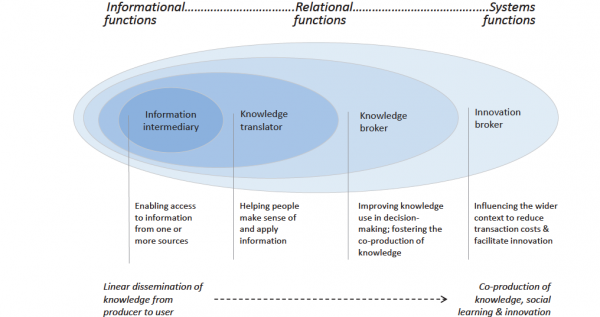Innovation Brokering
What is innovation brokering?
Innovation brokering describes those individuals or organisations who establish the connections between those who develop knowledge or innovations and those who will use the knowledge or innovation. Innovation brokering is not necessarily a job or a role, but rather a function which can be performed by organisations, or people within organisations.
Innovation brokers understand the ‘big picture’ or what the wider system is looking like and can connect different parts of that system to bring about better exchange of knowledge.
The diagram below shows the relationship between an innovation broker and other similar terms.

Diagram from Shaxson, Louise with Alex T. Bielak, et al. 2012. ‘Expanding our understanding of K*(KT, KE, KTT, KMb, KB, KM, etc.) A concept paper emerging from the K* conference held in Hamilton’, Ontario, Canada, April 2012. (p.3)
Innovation brokering within AgResearch
Innovation brokering is considered an important function of a ‘right teams’ approach to achieving impact. Certain roles within the organisation have key innovation functions as part of that role; for others, innovation brokering is part of wider set of competency descriptors.
What does a ‘success profile’ look like for Innovation Brokering?
(Based on a New Zealand Crown Research Institute)
Knowledge: What people know
- Systems thinking (contextualise specialist knowledge, farm systems)
- Applied technical knowledge relevant to end users
- Industry trends (market intelligence), popular press, field days, news, farmers
- Understand stakeholders' practical requirements and end user’s needs (current and future) - cooperatives and politics of each
- Contributions of network partners
- Industry constraints e.g. legislative, regulatory, stakeholder, market
- Government strategies
- Organisational strategy
- Funding streams
- New Zealand culture
- NZ science sector
Experience: What people have done
- Global (well-travelled)
- Work in different organisations
- Widely read (outside discipline)
- Extrapolate science process to farm
- Deal with a wide variety of people
- Interacted with stakeholders
- Communicate to non-scientists (e.g. articles)
- Communication in a range of situations
- > 10 years practical research
- Managed complex projects (start to finish)
- Conference and trade fair attendance
- Belong to recognised industry body
- Networking
Competencies: What people can do
- Values focused: support the organisation; operate with integrity; disclose own positions; remain open to ideas; support others; maintain professionalism.
- Collaboration: focus on stakeholders; identify partnership needs; explore partnership opportunities; formulate action plans; focus on shared goals; monitor partnership.
- Communication: deliver clear messages; communicate with impact; ensure understanding; influence others; provide linkage to strategy.
Personal Attributes: Who people are
- Initiating action: respond quickly; take independent action; go above and beyond.
- Innovation: challenge paradigms; leverage diverse resources; think expansively; evaluate multiple solutions; ensure relevance.
- Passion: maintain stamina; persist in efforts; maintain effectiveness; redirect focus.
- Impact: dress appropriately; display a professional demeanour; speak confidently.
- Leadership disposition: engage people; drive towards success; sustain positive outlook; show discipline; inspire confidence; learning agility.
